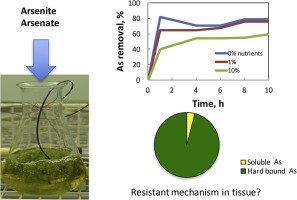Environmental Pollution ( IF 7.6 ) Pub Date : 2017-11-20 , DOI: 10.1016/j.envpol.2017.11.038 Arifin Sandhi , Tommy Landberg , Maria Greger

|
This work investigates whether aquatic moss (Warnstorfia fluitans) originating from an arsenic (As)-contaminated wetland close to a mine tailings impoundment may be used for phytofiltration of As. The aim was to elucidate the capacity of W. fluitans to remove As from arsenite and arsenate contaminated water, how nutrients affect the As uptake and the proportion of As adsorption and absorption by the moss plant, which consists of dead and living parts.
Arsenic removal from 0, 1, or 10% Hoagland nutrient solution containing 0–100 μM arsenate was followed over 192 h, and the total As in aquatic moss after treatment was analysed. The uptake and speciation of As in moss cultivated in water containing 10 μM arsenate or arsenite were examined as As uptake in living (absorption + adsorption) and dead (adsorption) plant parts.
Results indicated that W. fluitans removed up to 82% of As from the water within one hour when 1 μM arsenate was added in the absence of nutrients. The removal time increased with greater nutrient and As concentrations. Up to 100 μM As had no toxic effect on the plant biomass. Both arsenite and arsenate were removed from the solution to similar extents and, independent of the As species added, more arsenate than arsenite was found in the plant. Of the As taken up, over 90% was firmly bound to the tissue, a possible mechanism for resisting high As concentrations. Arsenic was both absorbed and adsorbed by the moss, and twice as much As was found in living parts as in dead moss tissue. This study revealed that W. fluitans has potential to serve as a phytofilter for removing As from As-contaminated water without displaying any toxic effects of the metalloid.
中文翻译:

水生苔藓对砷的植物过滤作用(Warnstorfia fluitans)。
这项工作调查了是否可能将源自矿山尾矿库附近的被砷(As)污染的湿地的水生苔藓(Warnstorfia fluitans)用于As的植物过滤。目的是阐明氟色W从砷和砷酸盐污染水中去除As的能力,养分如何影响苔藓植物吸收As的能力以及As吸收和吸收As的比例,该植物由死亡的和活的部分组成。
在192小时内,从含0-100μM砷的0、1或10%的Hoagland营养液中去除砷,并分析了处理后水生苔藓中的总As。检测了在含有10μM砷酸盐或亚砷酸盐的水中种植的苔藓中As的吸收和形态,作为植物活体(吸收+吸附)和死(吸收)部分中As的吸收。
结果表明,在没有营养物的情况下,加入1μM砷酸盐后,在一小时内,W。fluitans会从水中去除高达82%的As。营养物和砷的浓度越高,去除时间越长。高达100μM的砷对植物生物量无毒害作用。从溶液中除去亚砷酸盐和砷酸盐的程度相似,并且与所添加的As种类无关,在工厂中发现的砷含量比砷含量高。被吸收的砷中,有90%以上牢固地结合在组织上,这是抵抗高砷浓度的一种可能的机制。砷既被苔藓吸收,又被苔藓吸收,其吸附量是死者苔藓组织中的两倍。这项研究表明,W。fluitans 有潜力用作植物过滤器,以从被As污染的水中去除As而不会表现出准金属的任何毒性作用。










































 京公网安备 11010802027423号
京公网安备 11010802027423号